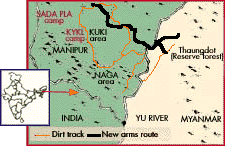Will blood flow in Manipur this autumn?
Soumen Datta

|
|
The secret map showing the arms route
|
"In autumn, blood, will flow freely in Manipur." This dire prediction is being made by intelligence agencies closely following the activities of the Kuki National Front, a belligerent force of Kuki tribesmen inhabiting parts of Manipur. Intelligence sources say the KNF is preparing to launch a massive attack, sometime in August-September, on Naga settlements lying close to Kuki villages as a sequel to long-standing feud that has cost both sides dearly.
Intelligence agents said the KNF is currently raising Rs 20 million to buy sophisticated weapons to boost their firepower. The KNF has reportedly collected Rs 4 million already.
The fund-raising campaign has been on for the past two months, but doubts persist about whether the Rs 20 million target that the KNF has set itself will be met by the end of August. But even if it fails to hit the jackpot, intelligence sources fear that the KNF will have close to Rs 10 million, enough to create serious trouble.
|
Insurgent groups in Manipur
Revolutionary People's Front (Kangleipak); Kangleipak Liberation Organisation; United Islamic Liberation Army; Meitei State Army; Revolutionary Joint Committee; Ireiba Kanba Lup; People's Republican Army; North-Eastern Council Army; Kuki Security Force; Chine Kuki Revolutionary Front; Kom Rem People's Convention; Zomi Revolutionary Volunteers; Village Volunteers Guard; Kuki Independent Army; Thangiling Hill Areas Defence Council; Vaiphei National Organisation; Special Sacrifice Force (Kuki); Kuki Defence Force; Kuki National Army; Kuki National Front; Kuki Democratic Movement; National Socialist Council of Nagaland; NSCN (Khaplang); Hmar People's Convention; Naga Lim Guard; People's Liberation Army; United National Liberation Front; People's Revolutionary Army of Kangleipak; Manipur Liberation Front Army; Kanglel Yaol Kanna Lup.
|
Intelligence sources are unwilling to name contributors to the KNF kitty, only broadly classifying them as government employees, contractors and Bengali villagers living in Manipur's Thoubal district.
Surveillance reports suggest the KNF is planning to go shopping in Myanmar, but the actual suppliers have not been identified. But a secret map has been unearthed, showing the route along which the arms are expected to flow.
Surprisingly, however, there is no sign that the security forces will bust the KNF plan, despite intelligence officials appearing to have details of the KNF's fund-raising drive and its ultimate intention.
Intelligence accounts also suggest the KNF is hell-bent on increasing its strike power against the powerful National Socialist Council of Nagaland, led by Isaac Swu and Th Muivah.The KNF and the NSCN (I/M) have been engaged in a running battle since the early nineties, often leading to the massacre of other Nagas and Kukis by militants on both sides.
The problem is that the Kukis want to be identified as Nagas while dominant Naga groups, especially the powerful Thangkuls to which Muivah belongs, reject them outright.
The hostilities between the two ethnic groups can be traced back to the days of British rule. After establishing control over Assam's Brahamputra Valley, the British tried to force passage to the Naga hills, but faced stiff resistance from the tribesmen. So the British sought the help of the Kukis in 1840, bringing them over from neighbouring Burma and giving them free ration and firearms to fight the Nagas. The strategy was immensely successful: Naga villages were plundered and Naga populations was driven to the hills, forcing their chiefs to make peace with the British.
But the resentment the Nagas have towards the Kukis never abated, and the two sides have often taken diametrically opposite views on crucial issues. While the Nagas have been fighting for a sovereign state since Independence, the Kuki National Assembly, formed in 1947, opted to remain within India.
It is perhaps why the Kukis have often been pampered by the administration. Reports say that the Kukis received official patronage after the Kuki-Naga clashes of 1992. Honglen, president of the Kuki National Organisation, met the then army chief General S F Rodrigues in 1992 and was known to be in touch with army officers thereafter.
Intelligence sources admit Kuki groups are being covertly supported by the government to bring pressure on the NSCN (I/M), which is also facing stiff opposition from its rival faction, the NSCN (K), led by Khaplang. The idea, clearly, is to force Muivah and his men to the negotiating table.
Kind: courtesy Sunday magazine
|







